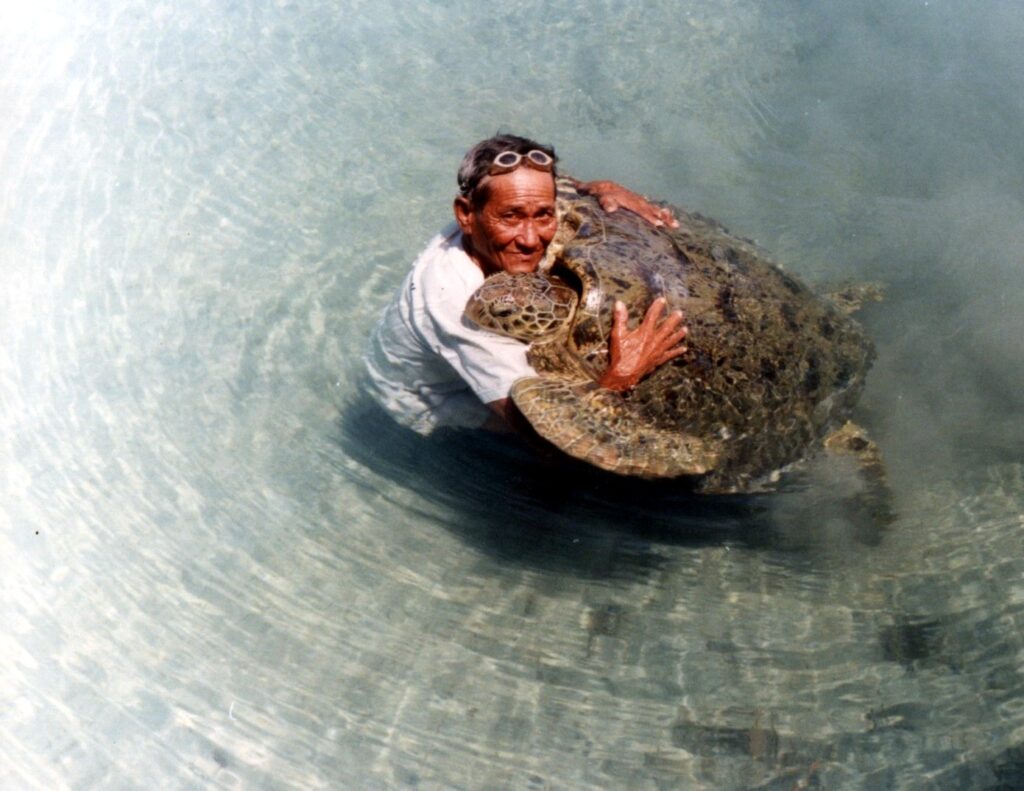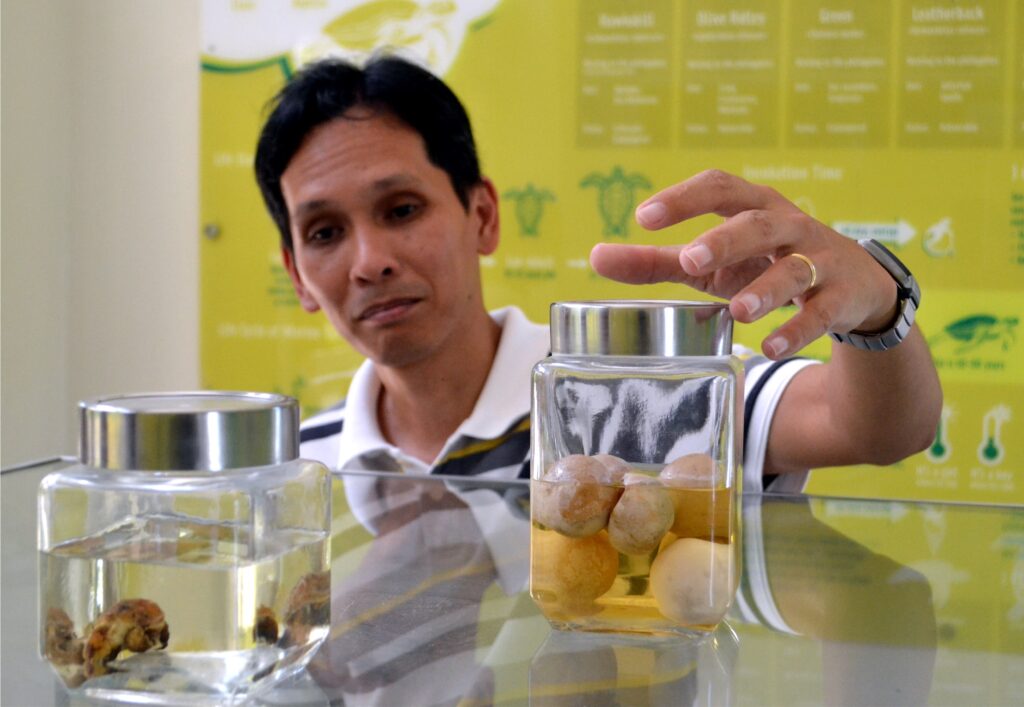Text and Photos by Henrylito D. Tacio
Additional Photo by AboitizPower
If a marine turtle, locally known as pawikan, can live up to 57 years, how much is its economical use value?
An estimated whopping P4.80 million, according to a study done by the Biodiversity Management Bureau (BMB), a line agency of the Department of Environment and Natural Resources (DENR).
The estimation was based on the animal’s ecological role in coastal and marine ecosystems (P900,000) and on the tourism value it generates (P3.90 million).
The DENR study was conducted under the Asian Development Bank (ADB)/Global Environment Facility (GEF) Project on Combating Environmental Organized Crime in the Philippines. It aims “to recognize the bigger picture,” as the protection of wildlife not only keeps ecosystems balanced but eventually benefits human well-being.
“The annual use value of the entire population of the Philippine marine turtle, which is conservatively estimated at 7,294 individuals, ranged between P2.89 billion and P3.19 billion (US$57.88-63.85 million) per year,” the study said.
The identified five species found in the country are Green Sea turtle (known in the science world as Chelonia mydas), Hawksbill turtle (Eretmochelys imbricate), Olive Ridley turtle (Lepidochelys olivacea), Leatherback turtle (Dermocheyls coriacea), Loggerhead turtle (Caretta caretta).

Marine Turtle 
Pawikan hatchlings
Most of the marine turtles in the Philippines are found in Baguan, Taganak, Lihiman, Boan, Langaan, and the Great Bakkungan, which are part of the so-called Turtle Islands. In the olden times, these islands were favorite weekend destinations of British excursionists and other nationals from North Borneo (now Sabah).
But marine turtles can also be found in other parts of the country. The Green Sea turtles have been sighted as far north as the Fuga Islands in Cagayan and in the Southwest in Bancuran, Palawan.
The Hawksbill turtles inhabit the Celebes Sea, the Cuyo island group of Palawan, the neighboring towns of Jolo, Cotabato, and Sitangkai in Tawi-Tawi, as well as in Sablayan in Occidental Mindoro and the open waters of the Sulu Sea. The Olive Ridley turtles have been seen by fishermen in the shallow coastal waters of Paluan, Occidental Mindoro.
The five species mentioned earlier are listed under Appendix I of the Convention on International Trade of Endangered Species of Wild Fauna and Flora (CITES), which means the trade of these marine turtles and its and subspecies is strictly “prohibited except for educational, scientific or research and study purposes.”
“All of the species found in our country are endangered except for the Hawksbill turtle, which is critically endangered,” said Dr. Arnel “AA” Yaptinchay, founder and director of Marine Wildlife Watch of the Philippines (MWWP), a non-government organization advocating for the conservation and protection of marine wildlife and their habitats.
“The only sure thing is that marine turtle populations are under tremendous threats. If these are not stopped, extinction is imminent,” he added.

Eggs and fetus of pawikan 
Rescued hawksbill turtle (Photo courtesy of Aboitiz)
Haribon Foundation for the Conservation of Natural Resources, a pioneer of the environmental movement in the country, believes so, too. “Unless Filipinos seriously take on the task of protecting the much-endangered marine turtles, these ancient creatures will soon be gone (from our waters),” it said in a statement.
According to MWWP, threats – whether human-made or not – impact marine turtles at all life stages, from eggs to adults. “It is impossible to prevent natural predation, mortalities due to natural causes, or changes to the environment brought about by climate change,” it said. “But reducing or even eliminating human-caused threats is possible.”
In the past and even until today, the biggest threat comes from the harvesting of eggs, juveniles, and adults. “Marine turtles are hunted for meat and leather; their eggs are taken for food and aphrodisiacs,” Haribon said.
The degradation of their habitat has also contributed to the decimation of marine turtles in the country. The ruin of the territories results from increased effluent and contamination from coastal development, construction of marinas, increased boat traffic, and harvest of near-shore marine algae resources.
Marine turtles are also affected by plastics. About 20% – or half a million tons – of the 2.7 million tons of plastic waste the Philippines generates annually leaks into the oceans, according to the 2015 report on plastic pollution by the Ocean Conservancy.
“Plastics endanger marine life and other animals, because they can mistake a piece of plastic for food when it isn’t,” a study pointed out. After eating plastic, they starve and die. Another study, published in the journal Scientific Reports, suggests that ingesting even a single piece of plastic can be deadly for these marine animals.
Marine turtles are also being threatened by climate change. “Potential impacts of global warming, such as projected sea level rise, can lead to shoreline erosion of small, low-lying tropical islands,” MWWP says. “Waves running up the shore during storms will wet the nests and increase egg mortalities at rookeries in these small islands, possibly decreasing the overall reproductive success of the marine turtle population.”
The Philippines, a CITES signatory, implemented the Pawikan Conservation Project nationwide through the Protected Areas and Wildlife Bureau (now known as Biodiversity Management Bureau) of the Department of Environment and Natural Resources in 1982. Since 2001, the hunting, sale, and killing of marine turtles have been banned in the country.
But despite sincere efforts made by the local and national government and some environmentalist groups to save marine turtles from disappearing in Philippine waters, the decimation of the endangered species continues unabated.
Aside from marine turtles, the BMB-DENR also conducted the economic use-value of the blue-naped parrot (known in the science world as Tanygnathus lucionensis): P186,000 throughout its six-year lifetime.
This is based on its trade value and tourism value (P5,000 when combined) and its ecological role in forest ecosystems (P181,000).
The entire Philippine parrot population was estimated at 8,500 individuals, according to the wildlife conservation group Katala Foundation. Its annual use value ranged between P36.23 million and P295.19 million per year.
Complementing the study findings, a willingness to pay survey was conducted in Cebu and Manila by the DENR-ADB/GEF Project to estimate the non-use value of marine turtles and blue-naped parrots.
The survey found an annual value of P9.30 billion for the Philippine marine turtle population and P33.38 billion for the local blue-naped parrot population.
This finding was in stark contrast to the traded value of one blue-naped parrot, which was only P5,000. In fact, the price was even lower in barangay Buliluyan, Batarza, Palawan, where the buying price per blue-naped parrot was only P200.
The economic study was released in time for the celebration of World Wildlife Day last March.
DENR Secretary Roy A. Cimatu is optimistic that the result of the study will allow “more people to be inspired in conserving and protecting our wildlife.”
“We hope that in popularizing the findings, we can entice more Filipinos to think about the long-term benefits of our wildlife such as marine turtles and blue-naped parrots, and not just short-time gains,” Cimatu said.
Environmental economist and study leader Dr. Agustin Arcenas added, “The economic valuation of resources is vital in monitoring whether steps to protect these resources are effective, as well as evaluating the efficiency of projects and programs geared toward managing the resources, especially in situations where no other feasible metric currently exists.”

